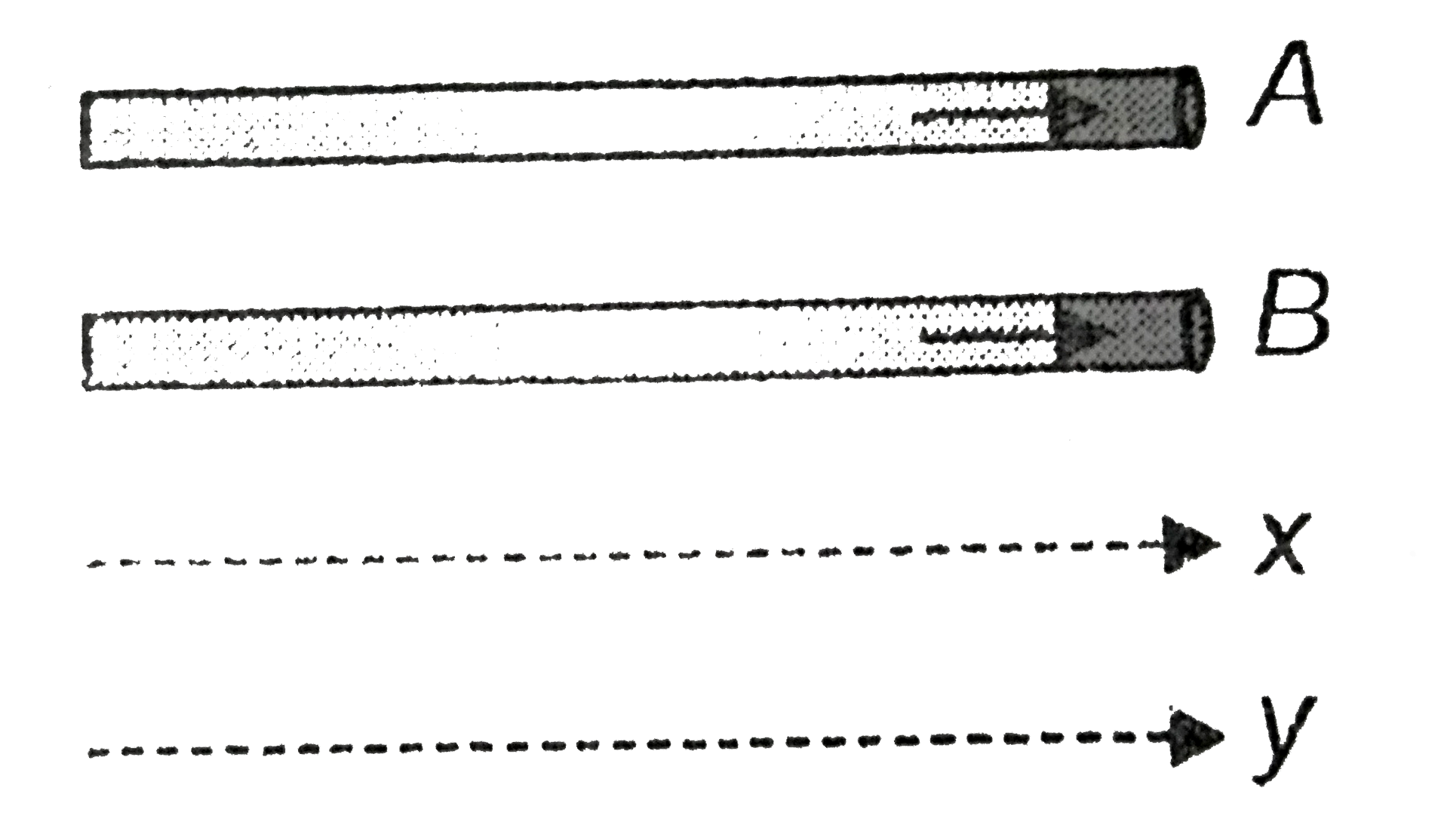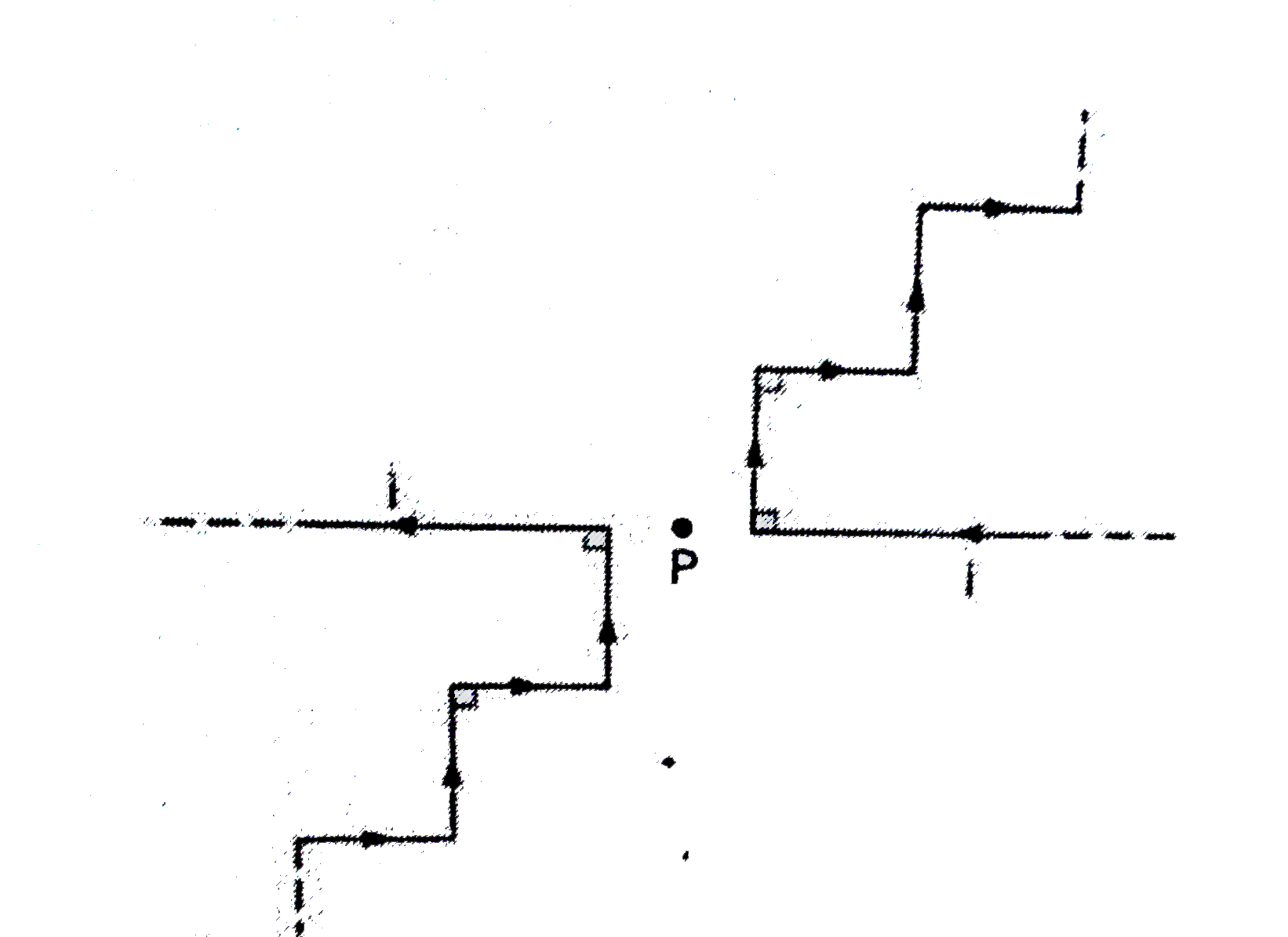Two parallel beams of protons and electrons, carrying equal currents are fixed at a separation d. The protons and electrons move in opposite directions. P is a point on a line joining the beams , at a distacne x from any one beam. The magnetic field at P is B . If B is plotted against x, which of the following best represents the resulting curve

##DPP_PHY_MEI_2_1_E01_099_O02.png" width="30%">


The correct Answer is:C
To solve the problem, we need to analyze the magnetic field produced by two parallel beams of protons and electrons that are carrying equal currents and moving in opposite directions. Let's break down the solution step by step.
Step 1: Understand the Configuration
We have two parallel beams:
- Beam 1: Protons moving upwards (current in the same direction).
- Beam 2: Electrons moving downwards (current in the opposite direction).
The distance between the two beams is D.
Step 2: Identify the Point of Interest
Let P be a point on the line joining the two beams, at a distance x from the proton beam. Therefore, the distance from the electron beam to point P is D−x.
Step 3: Magnetic Field Due to Each Beam
The magnetic field B due to a long straight current-carrying wire at a distance r is given by the formula:
B=μ0I2πr
where μ0 is the permeability of free space, and I is the current.
- Magnetic Field due to Protons at Point P:
BP=μ0I2πx
- Magnetic Field due to Electrons at Point P:
BE=μ0I2π(D−x)
Step 4: Determine the Net Magnetic Field at Point P
Since the protons and electrons are moving in opposite directions, the magnetic fields will have opposite signs. Therefore, the net magnetic field B at point P is:
B=BP−BE=μ0I2πx−μ0I2π(D−x)
Factoring out the common terms gives:
B=μ0I2π(1x−1D−x)
Step 5: Analyze the Behavior of B as x Changes
1. At x=D/2:
- The magnetic field B becomes zero because the contributions from both beams cancel each other out.
2. For x<D/2:
- The term 1x dominates, leading to B>0.
3. For x>D/2:
- The term 1D−x dominates, leading to B<0.
Step 6: Plotting B against x
- As x approaches 0, B approaches +∞.
- At x=D/2, B=0.
- As x approaches D, B approaches −∞.
This behavior indicates that the graph of B versus x will show a positive value for x<D/2, zero at x=D/2, and negative for x>D/2.
Conclusion
The resulting curve of B plotted against x will look like a hyperbola that approaches infinity as x approaches 0 and approaches negative infinity as x approaches D, crossing the x-axis at D/2.
We have two parallel beams:
- Beam 1: Protons moving upwards (current in the same direction).
- Beam 2: Electrons moving downwards (current in the opposite direction).
Let P be a point on the line joining the two beams, at a distance x from the proton beam. Therefore, the distance from the electron beam to point P is D−x.
The magnetic field B due to a long straight current-carrying wire at a distance r is given by the formula:
B=μ0I2πr
where μ0 is the permeability of free space, and I is the current.
BP=μ0I2πx
- Magnetic Field due to Electrons at Point P:
BE=μ0I2π(D−x)
Since the protons and electrons are moving in opposite directions, the magnetic fields will have opposite signs. Therefore, the net magnetic field B at point P is:
B=BP−BE=μ0I2πx−μ0I2π(D−x)
Factoring out the common terms gives:
B=μ0I2π(1x−1D−x)
1. At x=D/2:
- The magnetic field B becomes zero because the contributions from both beams cancel each other out.
- The term 1x dominates, leading to B>0.
- The term 1D−x dominates, leading to B<0.
- As x approaches 0, B approaches +∞.
- At x=D/2, B=0.
- As x approaches D, B approaches −∞.
The resulting curve of B plotted against x will look like a hyperbola that approaches infinity as x approaches 0 and approaches negative infinity as x approaches D, crossing the x-axis at D/2.
Topper's Solved these Questions
- BOOK - CENGAGE PHYSICS ENGLISHCHAPTER - SOURCES OF MAGNETIC FIELDEXERCISE - single correct Ansewer type12videos
SOURCES OF MAGNETIC FIELD
- BOOK - CENGAGE PHYSICS ENGLISHCHAPTER - SOURCES OF MAGNETIC FIELDEXERCISE - Subjective type10videos
SOURCES OF MAGNETIC FIELD
- BOOK - CENGAGE PHYSICS ENGLISHCHAPTER - RAY OPTICSEXERCISE - DPP 1.612videos
RAY OPTICS
- BOOK - CENGAGE PHYSICS ENGLISHCHAPTER - WAVE OPTICSEXERCISE - Comprehension Type14videos
WAVE OPTICS
Similar Questions
Two ideantical point charges are placed at a separation of d. P is a point on the line joining the charges, at a distance x from any one charge. The field at P is E,E is plotted against x for value of x from close to zero to slightly less then d. Which of the following represents the resulting curve
View SolutionA and B are two conductors carrying a current i in the same direction x and y are two electron beams moving in the same direction. There will be
 View Solution
View SolutionA and B are two conductors carrying a currwnt i in same direction x and y are two electron beams moving in the same direction .there will be
 View Solution
View SolutionTwo long parallel wires carry equal current I flowing in the same direction are at a distance 2d apart. The magnetic field B at a point lying on the perpendicular line joining the wires and at a distance x from the midpoint is
View SolutionTwo parallel wires P and Q placed at a separation
d=6cm carry electric currents i_1= 5A and i_2= 2A in <br> opposite directions as shown in figure. Find the<br> point on the line PQ where the resultant magnetic field
is zero.
 View Solution
View SolutionThe two ends of a uniform conductor are joined to a cell of e.m.f. E and some internal resistance. Starting from the midpoint P of the conductor, we move in the direction of current and return to P. The potential V at every point on the path is plotted against the distance covered (x). which of the following graphs best represent the resulting curve ?
View SolutionTwo parallel wires P and Q placed at a separation d =6 cm on x-axis carry electric current i1=5Aandi2=2A in opposite directions as shown in Fig. Find the point on the line PQ where the resultant mgnetic field is zero.
 View Solution
View Solution
Two infinitely long conductors carrying equal currents are shaped as shown. The short sectins are all of equal lengths. The point P is located symmetrically with respect to the two conductors. The magnetic filed at due to any one conductor is B. The total field at P isView SolutionA beam of electrons moving with a momentum p enters a uniform magnetic field of flux density B perpendicular to its motion. Which of the following statement(s) is (are) true?
View SolutionA beam of electrons moving with a momentum p enters a uniform magnetic field of flux density B perpendicular to its motion. Which of the following statement(s) is (are) true?
View Solution

